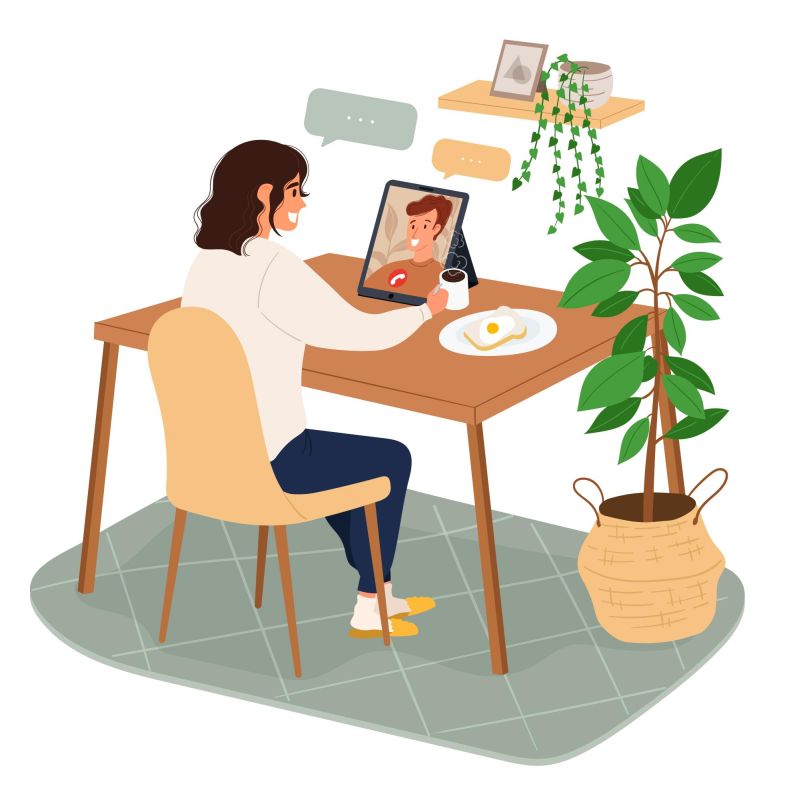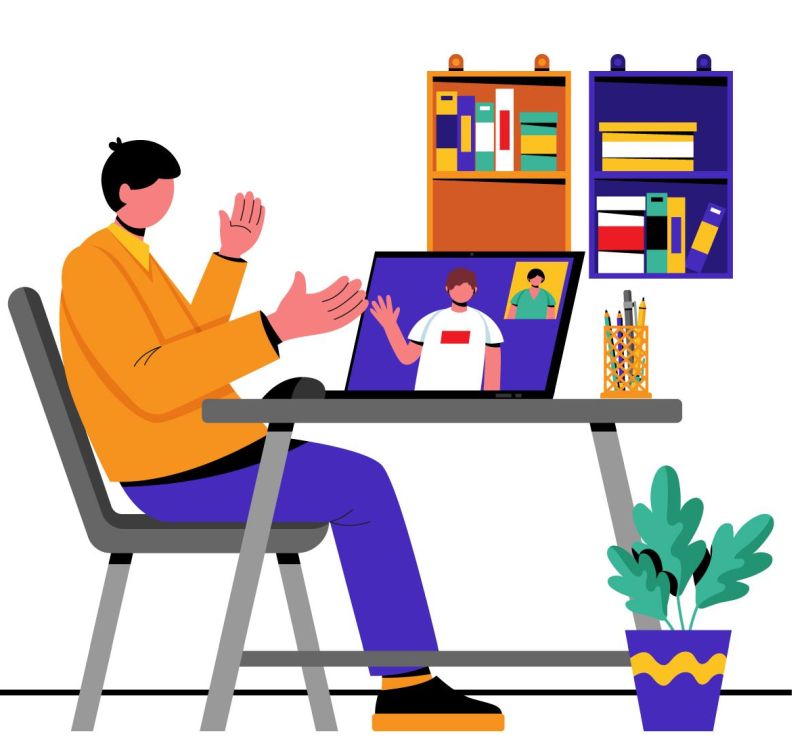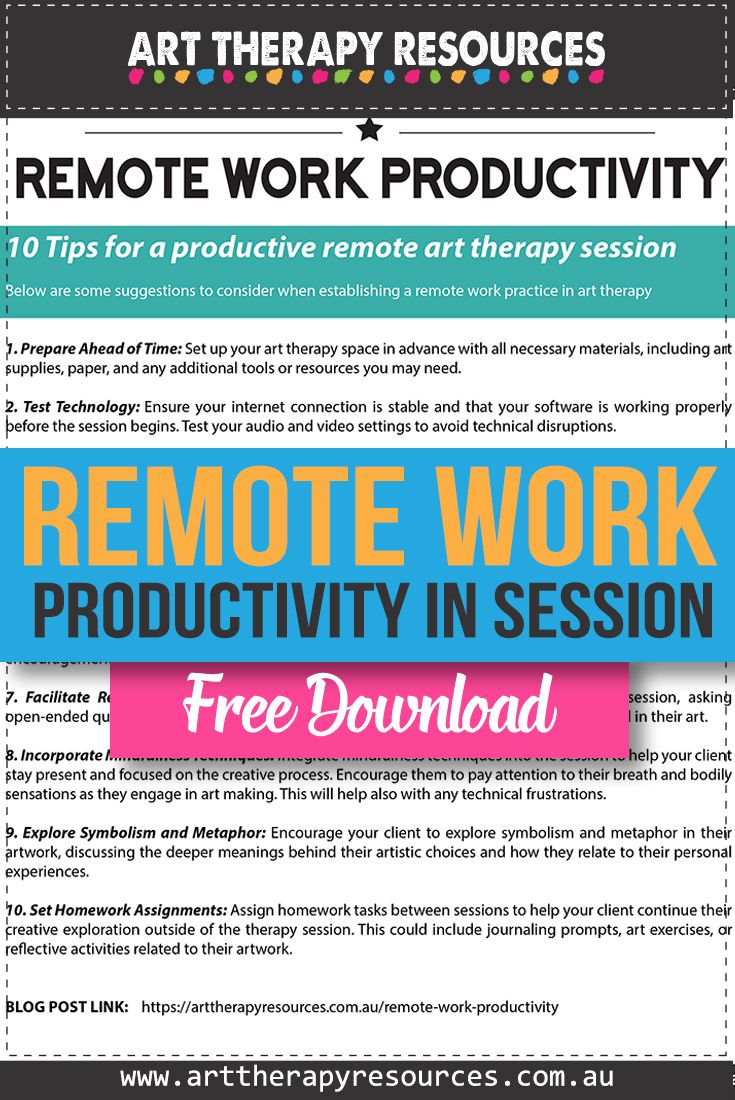THIS POST INCLUDES:
1. T he Dynamics of Remote Work
2. Strategies for Remote Work Productivity
3. Using Remote Work for Professional Growth
4. Free Download Remote Work Tips
THE DYNAMICS OF REMOTE WORK

The concept of remote work has permeated various professions, and art therapy is no exception. As art therapists navigate digital platforms to facilitate sessions and manage their private practices remotely, a nuanced approach to productivity becomes paramount. This blog post explores practical tips tailored for art therapists seeking to enhance their productivity with remote work. This post isn’t about establishing a remote practice, but instead focused on the strategies for being productive when working remotely.
Embracing remote work requires a fundamental shift in the way art therapists conceptualize their therapeutic space. The physical studio transforms into a virtual canvas where the therapist must leverage digital tools to create a conducive environment for artistic expression and therapeutic dialogue.
Establishing a Dedicated Remote Work Space
Creating a dedicated remote work space is instrumental in fostering focus and creativity. Whether it’s a corner of a room or a designated home office, a well-defined space signals a purposeful intention to focus on therapeutic activities, even within the digital landscape. This intentional separation aids in maintaining a professional mindset.
Utilizing Technology to Enhance Engagement
Remote work necessitates a judicious integration of technology to aid engagement between the art therapist and client. Art therapists can explore platforms that facilitate seamless communication including screen sharing for art exploration, and secure spaces for the exchange of creative expressions. Technological proficiency becomes an asset in creating a dynamic virtual therapeutic encounter.
STRATEGIES FOR REMOTE WORK PRODUCTIVITY

Structuring Sessions Effectively
Remote work requires establishing a useful structuring of therapy sessions that both takes advantage and accommodates the different nature of working virtually instead of in person.
Developing clear agendas, defined objectives, and a strategic allocation of time contribute to a seamless therapeutic experience. Structured sessions also help in managing the challenges associated with virtual engagement, such as potential technical issues.
To reduce the amount of time spent on troubleshooting potential technical issues, it’s a good idea to establish a strong protocol for using various programs and the equipment required. When you begin providing therapy to new clients, you can mitigate these potential issues by providing a ‘welcome packet’ that explains the process of working together online. This should outline the potential issues and how to fix them. You should also develop policies that address how you work with clients when sessions disconnect due to technical faults. Clients should not be disadvantaged financially if technology fails on both sides.
Leveraging Visual Aids and Prompts
Visual aids and prompts are essential in a remote art therapy setting. Therapists can use digital whiteboards, visual prompts, and online resources to augment the creative process. These tools serve as bridges, connecting the therapeutic dialogue with the visual expressions of the clients.
As mentioned before, any time technology is introduced, you should undertake a review of how systems might fail and what you can implement to overcome those challenges.
Establishing Clear Communication Channels
Effective communication lies at the core of successful remote work. Art therapists should establish clear channels for communication with clients, including guidelines for virtual sessions, expectations, and mechanisms for sharing artworks. Transparent communication fosters a sense of connection in the digital space.
This follows on from the point made before about providing your clients with a welcome packet on what they can expect and what is expected of them when preparing for remote sessions. It’s important to remember that we are in an age when we are establishing remote work and virtual therapy as a viable option. This means successes and fails will occur as we work out the best method to bring into our therapy practice. Having an open mind on developing new approaches is vital.
Adapting Art Interventions to the Digital Medium
Art therapists need to adapt traditional art interventions to the digital medium effectively. Providing guidance on digital art tools, encouraging the use of home art supplies, and tailoring interventions to suit the virtual canvas ensure a seamless transition from in-person to remote artistic exploration.
Cultivating Flexibility and Adaptability
Flexibility is a cornerstone of successful remote work. Art therapists should cultivate an adaptive mindset, being open to adjusting strategies based on client needs and the evolving dynamics of the virtual therapeutic relationship. Flexibility fosters resilience in navigating the complexities of remote art therapy.
USING REMOTE WORK FOR PROFESSIONAL GROWTH

Aside from client work, remote work offers art therapists the opportunity for continuous professional development in the virtual sphere. Engaging in online workshops, webinars, and training programs enhances therapeutic skills.
Remote work extends beyond client sessions to include remote supervision and mentorship opportunities. Art therapists can benefit from seeking guidance and mentorship from experienced professionals, even if they are geographically distant.
Art therapists can identify relevant online resources that offer workshops and training programs in art therapy and related areas. Select courses aligned with their professional goals and interests.
Art therapists should incorporate dedicated time slots in their schedule for virtual learning activities. Whether it’s setting aside a few hours each week or participating in live webinars during non-client hours, prioritize ongoing professional development is important to developing as an art therapist.
Art therapists can also facilitate peer learning groups within the art therapy community, where therapists can collectively enrol in online courses and discuss course content. This collaborative approach not only fosters a sense of accountability but also promotes knowledge sharing and mutual support.
Art therapists can benefit from participating in virtual peer consultation groups. These groups provide a forum for therapists to discuss clinical cases, share insights, and collaboratively problem-solve challenges encountered in their practice. It is important that the principles of privacy and confidentiality are prioritized when discussing case work in a group setting.
FREE DOWNLOAD: Art Therapy Exercise

BUILD YOUR ART THERAPY REFERENCE MATERIALS:
Pin this image to your Pinterest board.

SHARE KNOWLEDGE & PASS IT ON:
If you’ve enjoyed this post, please share it on Facebook, Twitter, Pinterest. Thank you!
